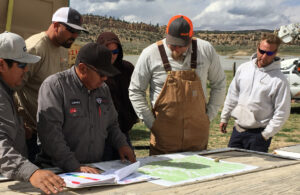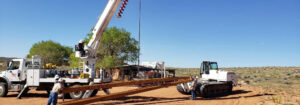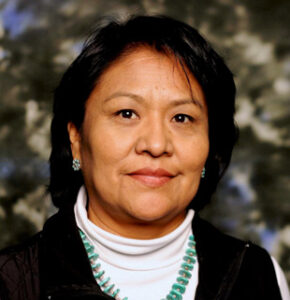The Navajo Tribal Utility Authority (NTUA) operates electricity, communications, and other utilities for the 27,000‑square-mile Navajo Nation. The 2019 mutual aid project Light Up Navajo and 2020 funding under the Coronavirus Aid, Relief, and Economic Security (CARES) Act brought power to some of the approximately 14,000 homes on the Navajo Nation that lacked electricity. Hydro Leader spoke with Government and Public Affairs Manager Deenise Becenti about the success of that effort and about the next phase, Light Up Navajo 3, which is slated to start in April 2022.
Hydro Leader: Please tell us about your background and how you came to be in your current position.
Deenise Becenti: I’m the government and public affairs manager for NTUA and handle all of NTUA’s communications. I’ve been with NTUA for more than 20 years.
Hydro Leader: Please introduce NTUA.
Deenise Becenti: NTUA was established by Navajo leaders in 1959. They created it to address utility access in the Navajo Nation, which is 27,000 square miles in size, roughly the size of the state of West Virginia. They believed that a Navajo-owned utility would best meet the needs of the Navajo people. Since then, NTUA has grown into a self-sustaining, not-for-profit, tribally owned enterprise. It is among a dozen or so tribal entities or enterprises owned by the Navajo Nation, all of which operate separately from the Navajo Nation government umbrella. At NTUA, we handle the business operations and oversee the maintenance of our electric, communications, natural gas, water, wastewater, and renewable energy generation utilities, including off-grid residential solar services for the Navajo people. In addition to providing multiutility services, we are here to help generate a new economy, to create employment opportunities, to keep utility rates stable, and to improve the health and welfare of residents throughout the Navajo Nation.

Hydro Leader: In addition to the power generated on the reservation, does the utility also buy power from outside producers?
Deenise Becenti: We do. Since we established our own utility-scale solar farm in 2019, a large portion of our electric utility comes from our 55‑megawatt solar facility, the first of its kind here in the Navajo Nation. It was built in two phases, with the intent to demonstrate that the Navajo Nation can build, develop, and maintain a utility-scale renewable energy facility. We also purchase power from outside the Navajo Nation. Right now, 58 percent of our power is generated from renewable energy sources.
Hydro Leader: What percentage of your power is generated by hydropower?
Deenise Becenti: In 2019, 40 percent of our power was sourced from renewable energy sources—both hydro and solar power. In 2020, when the second phase came online, it went to 57 percent, so about half the power that is distributed here in the Navajo Nation comes from renewable energy sources.
Hydro Leader: Would you tell us about the Light Up Navajo program?
Deenise Becenti: Light Up Navajo was created in 2018. It developed from a partnership between NTUA and the American Public Power Association (APPA), a national organization that community-owned utilities are part of. Utilities send their crews to locations where natural disasters have occured to help restore power to those regions. Our general manager, Walter W. Haase, is the former chairman of the APPA. During his presentations at conferences and at national meetings, he has talked about his own utility and described the challenges that we face daily and the thousands of residents who were without electric power. People started coming up to him to ask what they could do to help. They were surprised that a region within the United States had 14,000 homes without electricity.
In 2019, we launched Light Up Navajo as a pilot project. Twenty-eight communities from 13 states sent their crews here for a concentrated 6‑week effort to connect as many homes as possible. We had utilities from Arkansas, California, Delaware, Illinois, and Utah, as well as from neighboring utilities. Together, 138 line workers extended power to 233 homes and extended 50 miles of line. Because that effort was so successful, in 2020, we were planning to host Light Up Navajo 2. Of course, the pandemic changed all that. After the pandemic canceled our plans for Light Up Navajo 2, those families got connected under the CARES Act, which provided funds from the federal government to combat COVID‑19. Our utility crews went to work in August 2021, and in 6 weeks, they were able to connect over 700 homes.
Hydro Leader: Will Light Up Navajo 3 take place in 2022?

Deenise Becenti: Yes; it will start in April. Right now, our teams are busily preparing these projects—getting rights-of-way clearances and land clearances. A lot of these homes may not have proper house wiring, so we’re getting those homes prepared. That way, when the Light Up Navajo teams arrive, they can immediately start work to connect homes to the main power grid.
Hydro Leader: Is there anything you would like to add?
Deenise Becenti: They call Light Up Navajo mutual aid without the storm. Many of the line workers who come here have an eye-opening experience, because many of them come from communities where electricity is everywhere. They’ve connected newly built homes, but they haven’t connected homes where families had been living for years. To see the heartfelt gratitude of families who were waiting years for electricity demonstrates just how meaningful this project is.
Hydro Leader: What is your vision for the future of NTUA?
Deenise Becenti: Our vision is to continue moving forward with the vision that was established in 1959: to be a utility business that is Navajo owned, Navajo operated, and that truly meets the needs of the Navajo Nation. Since then, we’ve grown beyond expectations, but our commitment to that vision hasn’t wavered.
Deenise Becenti is the government and public affairs manager of the Navajo Tribal Utility Authority.


